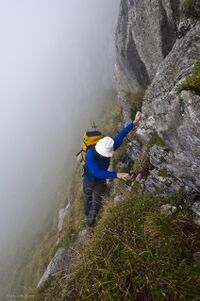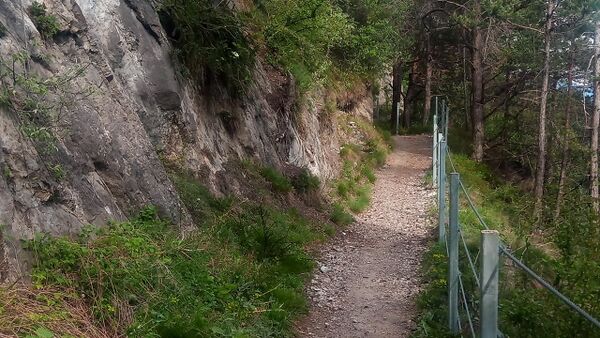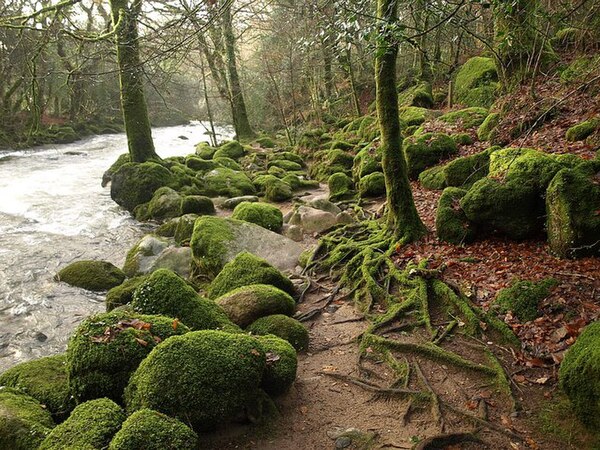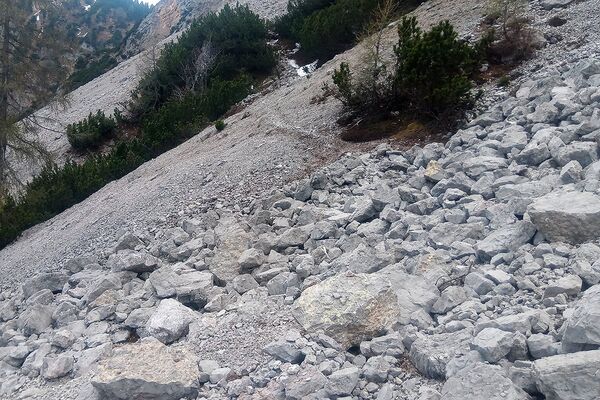Key:sac_scale
| Description |
|---|
| A difficulty rating scheme for hiking trails. |
| Group: properties |
| Used on these elements |
| Implies |
| Useful combination |
| Status: approved |
| Tools for this tag |
|
The key sac_scale=* is used to classify hiking trails in mountainous areas with regard to the difficulties to be expected.
The scale discerns six grades in ascending level: From hiking (T1) up to difficult_alpine_hiking (T6). It is based on the SAC Mountain and Alpine Hiking Scale.
All properties dealing with visibility of the path have been separated to trail_visibility=*
How to map
Add the key sac_scale=* to a way with one of the following primary feature tags:
- highway=path - A generic or multi-use path open to non-motorized traffic
- highway=track - A minor land-access road like a farm or forest track
- highway=footway - For designated footpaths, i.e. mainly/exclusively for pedestrians
General notes
- Use this tag solely on ways used for hiking, as it solves a domain specific need. If local conditions cannot be expressed in terms of the SAC_scale, then do not use this tag.
- A highway=track can carry a sac_scale=* tag if commonly (dual-)used for hiking or marked with hiking signs (Alpenverein, tourist authority). Then the sac_scale=* most likely will be hiking, or rarely mountain_hiking (if hazardous/slippery, map navigation required, etc.)
As the base description is a direct translation from the Swiss Alpine-Club publication, the scheme is primarily suited for mountainous areas. Other regions present other difficulties and requirements, and therefore other schemes might apply better. E.g a way in a flatland forest that is difficult to walk because of muddy ground or fallen trees does not classify for T2 ("mountain_hiking"). Other schemes need to be used to describe its condition.
Most hiking trails that are found in printed maps fall into the "hiking" and "mountain_hiking" categories. In low mountain ranges ways are often T1 ("hiking") only, although higher grades are possible.
A way may not fit all of the criteria listed below for trail, terrain and requirements. In general, use the greatest difficulty that is matched.
A note on mountaineering boots: Such boots are heavier and torsionally stiffer than the popular trekking or hiking boots. Ideally they make it comfortable to walk for hours with crampons, at least they make it easy to kick steps into snow crust or slippery soil. [1]
Values
| Value | SAC scale and Swiss marking colour | Trail | Terrain | Requirements | Illustration |
|---|---|---|---|---|---|
| hiking | T1
yellow |
Trail well cleared. Exposed areas well secured. | Terrain level or slightly inclined; no risk of falling with appropriate behaviour. |
|

|
| mountain_hiking | T2
white with red stripe |
Continuous trail with a steady ascent. | Terrain is steep in places and may pose fall hazards. |
|
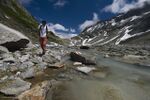
|
| demanding_mountain_hiking | T3
white with red stripe |
Exposed areas ordinarily secured with ropes or chains. Use of hands for balance potentially needed. | Portions of the route exposed with danger of falling. Trail may have unmarked portions and cross fields of loose scree or talus. |
|
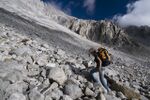
|
| alpine_hiking | T4
white with blue stripe |
Use of hands needed in order to advance in certain places. | Terrain already quite exposed, including steep grassy pitches, talus slopes, easy snowfields, or snow-free glacier crossings. |
|
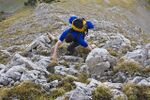 
|
| demanding_alpine_hiking | T5
white with blue stripe |
Individual easy climbing sections. | Exposed and demanding terrain. May include steep rock scrambles, glaciers and snowfields with risk of sliding. |
|
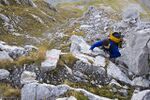 
|
| difficult_alpine_hiking | T6
white with blue stripe |
Includes climbing pitches up to UIAA grade II. | Severe exposure. Difficult craggy terrain. Glaciers with high risk of sliding. |
|
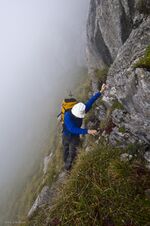 
|
The illustration images above have been provided by Marco Volken, member of the SAC trail classification working group.
On the ground markings in Switzerland
The 2023 revision of the SAC Mountain Hiking Scale specifies a blurred matching: See German French Version
| Tag | If marked on site more | less (likely) | ||
|---|---|---|---|
| sac_scale=hiking | T1 | ||
| sac_scale=mountain_hiking | T2 | ||
| sac_scale=demanding_mountain_hiking | T3 | ||
| sac_scale=alpine_hiking | T4 | ||
| sac_scale=demanding_alpine_hiking | T5 | ||
| sac_scale=difficult_alpine_hiking | T6 | ||
More pictures
| Trail well paved. Exposed areas well secured. | |
| Continuous trail. Basic surefootedness required.
In a poll of the German community 16 out of 31 voted this picture shows hiking while 15 considered it mountain_hiking. [2] | |
| Trail not continuous. |
Controversy
Based on the guidelines of verifiability some people find this tag lacking of verifiability. Please have a look at the discussion page at Talk:Proposed features/Hiking. As always on OSM you are free to use the tags you like. Before changing an already existing value, the mapper who set the prior value might be contacted.
Reasons to use it
- Especially for mountain trails, it is crucial to know whether a trail can be done in sneakers/trainers or whether you need an ice axe and crampons.
- Many commercial maps are not designed for hiking (because they denote only very few trails), this is a region where OSM can be of great value soon and for a long time.
- Many mountaineers already utilize GPSs. It would be great to win as many of them as possible as contributors to OSM.
Possible tagging mistakes
See also
- mtb:scale=* - a classification scheme for mountain bike trails
- Consider using incline=up/down to specify the direction of the way up or down the mountain.
- climbing:grade:uiaa=* - UIAA Grade for Rock Climbing [3]
- assisted_trail=* - Indicates that the dangerous or difficult sections of a hiking path are secured by technical means
- Hiking
- Hiking Maps to see how this tag is rendered by OSM hiking maps
- Safety measures on hiking trails
- Proposed features/via ferrata
- JOSM Mappaint style
- Approved proposal for this tag
